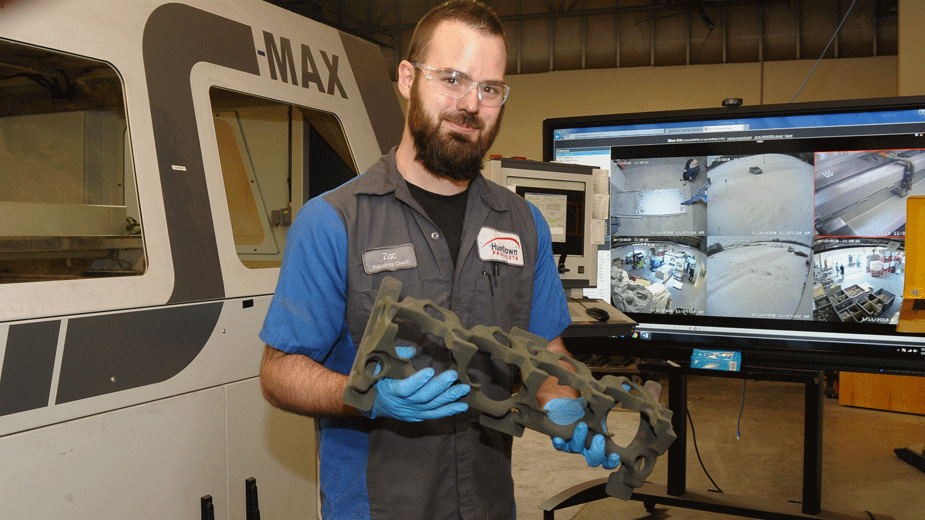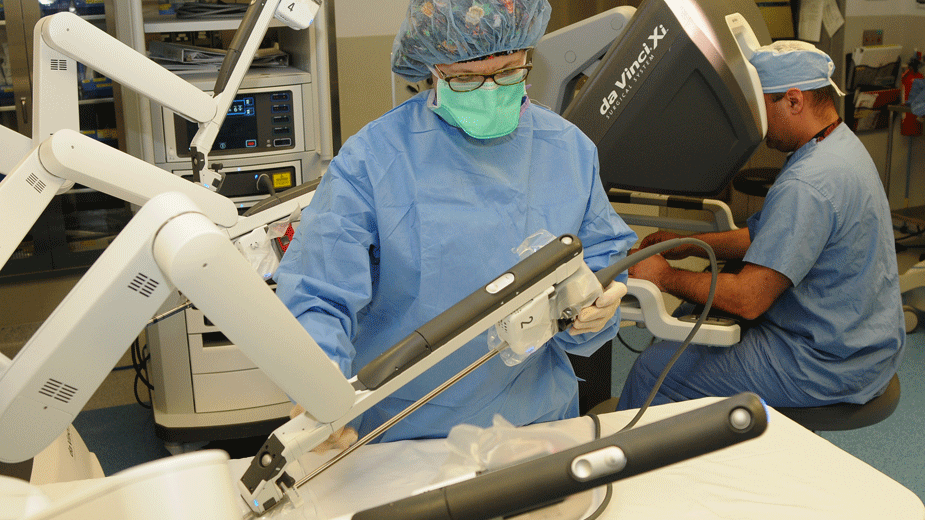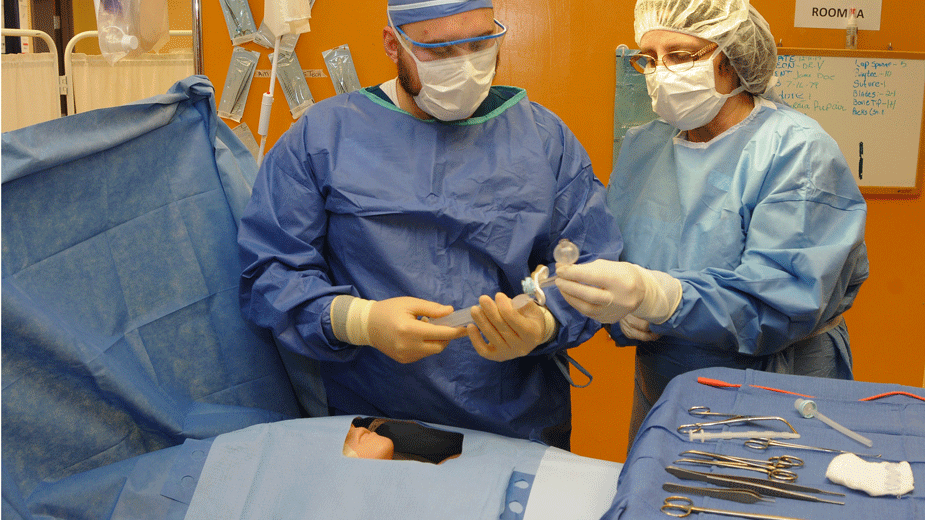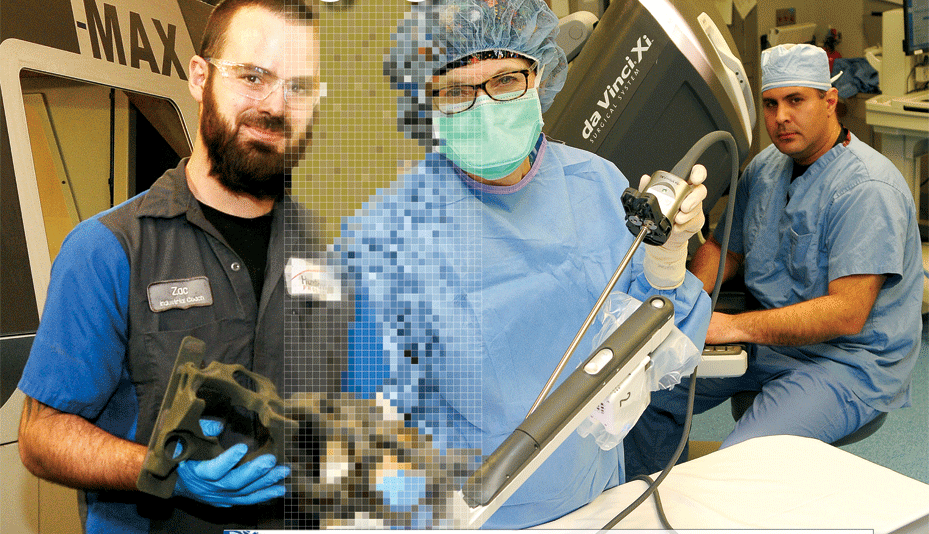Growth Report 2018: The Changing Nature of Work
YOUNGSTOWN, Ohio — Laurie Saxon of Boardman thought she hit the jackpot three years ago when she was hired for a position at General Motors’ Lordstown Complex. As an employee in the plant’s trim shop, Saxon was earning good money performing duties such as installing end caps on vehicle dashboards, routing windshield wiper hoses and affixing pads to the hoods of just-built Chevrolet Cruzes.
Then early last year, sagging sales of the Cruze forced the Lordstown plant to reduce its workforce to two shifts from three, effectively eliminating more than 800 jobs, including Saxon’s. Now, approaching age 40, she had some decisions to make.
The answer was health care.
“I wanted to be in a field that I could stay in, one that was secure.” Saxon says. “I don’t want to be laid off again.” Today, after evaluating the prospects for employment in that market, she’s pursuing training as a surgical technician through Choffin Career and Technical Center’s adult education program.
Saxon’s story demonstrates the changing nature of work in the Mahoning and Shenango valleys. During the first 70 years of the 20th century, the region was a manufacturing powerhouse. It had been built on steel, the Mahoning River being the spine of sprawling steel mills.
While the age of Big Steel is long gone, the Mahoning Valley’s transition from a traditional manufacturing center continues to this day. Since the 1990s – a period when the economy underwent its largest peacetime expansion in history – the number employed in the manufacturing in the region has consistently dwindled.
At the same time, employment in other sectors of the local economy has increased – health care, transportation, retail and services – positions that tend to pay lower wages than the lucrative production jobs of the past.
“In two days, it’ll be one year since that happened,” reflects Saxon on her last day of work at GM Lordstown.
She’d worked in other jobs throughout the years – as a secretary, at a local bank – but the GM position appeared secure because of the high demand for the fuel-efficient Cruze, the small passenger vehicle manufactured at Lordstown. Once demand for the small car swooned and she was placed on layoff, she started searching for a position that could afford her a sense of stability for the rest of her life.
By June, she expects to complete her coursework and earn certification as a surgical technician, which she says opens the doors to a host of new opportunities. “This is a big change,” she says. “But I’m really glad I’m doing this.”
The need to find job security is a challenge workers in the region are all too familiar with, says John Russo, visiting scholar at the Kalmanovitz Initiative for Labor and Working Poor at Georgetown University and the former co-director of the Center for Working Class Studies at Youngstown State University. “This is something the working people of Youngstown have known for some time.”
Russo points out that technology isn’t affecting just manufacturing and wage earners, but other sectors of the economy that employ salaried and strong middle-class professions as well. Health care, media, retail and other services once thought immune to automation and technology feel the impact.
“It’s led to many corporations subcontracting positions” relative to areas such as finance, he says.
While there’s little argument that major producers since the 1990s have reduced their U.S. workforce by moving production jobs overseas, there are other factors that have affected the nature of employment and work in this region and across the country.
“It’s not just globalization. It’s also corporate decision-making,” Russo says. Automation and advanced manufacturing have opened opportunities for more knowledge-based and skilled positions, but these operations require fewer people. How manufacturers and corporations implement automation technology “is equally important,” Russo says.
At Humtown Products Inc. in Columbiana, workers are busy on the production floor handling large presses that manufacture sand cores for the foundry industry. These cores will be used to form components for products turned out by manufacturers who serve the heavy equipment and rail industries.
“We’re actually fairly automated here,” says Mark Lamoncha, president of Humtown. “But we want to put the automation in the hands of those who know how to use it.”
Each Humtown employee is given a wireless hand-held device that tracks quality and production in real time.
“They use these a lot,” Lamoncha says.
But much of the Humtown’s plant also is devoted to traditional manufacturing and the sand cores created here use the same processes as 40 years ago. After a slow start last year, the market Humtown serves has rebounded significantly.
“Companies such as Caterpillar have gained huge traction,” Lamoncha says, while the rail business has been revived because of an upturn in the coal market.
This new business has translated into the need for additional jobs at Humtown to keep pace with demand, Lamoncha says.
“We’ve hired 14 since September,” he reports, filling positions in press operation, finishing and trimming. “That’s about a 30% increase.”
More notably, a notice pasted to one of the doors of the old factory advertises a position available in the company’s sister operation about 10 miles away in Leetonia.
This posting, however, isn’t for your traditional press operator. Rather it’s for someone to work in Humtown’s 3-D printing department.
“This is running 24/7,” says Zach Johnston, who operates a large-scale 3-D printer at Agile Casting Solutions, the division of Humtown operating in World Trade Park just outside Leetonia. The venture is a partnership with Youngstown State University, the Youngstown Business Incubator and Youngstown-based America Makes.
 Zach Johnston holds a sand core printed by Humtown Products Inc.’s 3-D printer in Leetonia.
Zach Johnston holds a sand core printed by Humtown Products Inc.’s 3-D printer in Leetonia.
The company’s use of additive manufacturing – an automated process in which material is deposited through a nozzle akin to a printer head and builds components from the ground up – has helped it develop products it couldn’t through conventional manufacturing means.
“It’s certainly a different piece of machinery,” observes Johnston, who holds a degree in automotive technology. He points to a carrier rack that holds sand cores for water jets, which require a much denser sand composition that’s difficult to replicate through traditional presses.
“We used to make hundreds of these at the core shop and maybe end up with two or three good ones,” Johnston says. “When we print these, 100% go out the door.”
These technical advances in manufacturing come during a period when there have been no real gains in manufacturing employment in the Mahoning and Shenango valleys.
Indeed, data show that since 1990, the composition of work has shifted from a strong manufacturing economy to one today that is dominated by medical and educational occupations. (See charts on page 3.)
According to the U.S. Bureau of Labor Statistics, the Youngstown metropolitan statistical area, which includes parts of western Pennsylvania, employed 62,300 in the manufacturing sector in 1990, or 22% of the workforce. As of November 2017, that number had plummeted to 27,700, today constituting just 11.2% of the workforce.
So, what happened to the 34,600 manufacturing positions lost over these 28 years and how many were replaced?
A shrinking population – there were 283,147 in the labor force in January 1990 compared to 245,625 in November 2017– has contributed to the decline. But so have plant closings such as RG Steel, more automated systems, as well as cutbacks at major employers such as Delphi Corp. and GM Lordstown.
What is clear is that the region has filled many of those lost jobs with those gained in other sectors.
Positions in health care and education services, for example, increased from 30,800 in those fields in 1990 to 43,300 as of the close of 2017 – a gain of 12,500 jobs. In 1990, the sector held 10.5% of the workforce. Today, it’s 17.6%.
In Mahoning County, a Policy Matters Ohio study released last year shows that in 2015, health care occupations constituted 18.8% of the total private sector workforce, up from 13.9% in 2008.
“Mercy Health is the single-largest employer in the Mahoning Valley,” notes Don Koenig, president of Mercy Health St. Elizabeth Youngstown Hospital.
 Sharon Wade, a nurse at Mercy Health St. Elizabeth Youngstown campus, and Dr. Thomas Chirichella, surgeo, demonstrate the capabilities of the daVinci robotic surgical system.
Sharon Wade, a nurse at Mercy Health St. Elizabeth Youngstown campus, and Dr. Thomas Chirichella, surgeo, demonstrate the capabilities of the daVinci robotic surgical system.
Mercy Health’s system – which includes St. Elizabeth Youngstown, St. Elizabeth Boardman and St. Joseph hospitals and several outpatient clinics – today employs abut 4,400. At one time, the hospital system ranked fourth behind major employers such as GM and Delphi, Koenig says.
In late April, the downtown campus on the North Side will open a new 26-bed intermediate-care unit and looks to fill between 35 and 40 nursing positions, Koenig says, while another 20 to 25 positions will be needed to help staff a new oncology infusing center opening in early April. “It’s very exciting,” he says.
At the same time, the hospital system has invested in new technology, especially in its surgical center. The latest acquisition was the daVinci Xi robot, a highly sophisticated surgical system that helps surgeons perform operations that are less invasive to the patient.
“It’s pretty amazing the level of technology we have,” says Dr. Tom Chirichella, who specializes in hepatobiliary and pancreatic surgery. “It’s amazing how far we’ve come.”
Through the daVinci, the arms of the robot act as an extension of the surgeon’s as he maneuvers and manipulates the action from a control console in the room. A 3-D viewer allows for substantial magnification, enabling the surgeon to examine the patient in better detail. “It’s changing how we do surgery,” Chirichella says, noting that robotic surgery greatly reduces recovery time for the patient.
Koenig says to fill the jobs Mercy Youngstown will create this year, it will recruit from nursing candidates at Youngstown State University and from its own nursing school. Meanwhile, he sees a growing demand for lab technologists.
“There are a lot of laboratory staff approaching 30 and 35 years of service who are nearing retirement,” he says. “There are not enough four-year lab techs coming out to [meet] demand.”
Still, growing demand in health care, propelled in this region by an aging population who will require more care, is helping initiatives such as Choffin’s surgical tech and nursing programs.
 Curtis Flaviani, a student in Choffin Career and Technical Center’s surgical tech program, works with instructor Christine D’Amore-Gray.
Curtis Flaviani, a student in Choffin Career and Technical Center’s surgical tech program, works with instructor Christine D’Amore-Gray.
“The last class that graduated from the program registered a 100% placement rate,” says Carole Dubos director of Choffin’s surgical tech program. “There are a minimal amount of layoffs in this field.”
On average, the pay for a surgical tech ranges from $14 to $19 per hour, she says.
Curtis Flaviani, a student in this year’s class, says that the program appealed to him after he served in the Air Force. “This fit me,” he says. “We’re a little more than halfway through and I’ve already had opportunities for jobs. So there’s definitely a market.”
Choffin’s licensed practical nursing program has also witnessed increased interest in that field, says its director, Susan Desko. There is a general sense that companies are looking to hire more LPNs on staff, mostly for home health services, area nursing homes or assisted living centers.
“Of the 19 who graduated last year, every single one of them were hired immediately,” Desko says.
Those who have lost their jobs in manufacturing have several choices open to them, says Bert Cene, director of the Workforce Development Board of Mahoning and Columbiana Counties. Training opportunities in new careers such as health care is one while training and upgrading existing skills that allow pursuit of another job in the manufacturing sector is another, he says.
“You just don’t have the ability to walk into a plant as an unskilled laborer and make good money,” Cene says. “Today, you’re going to need skills and credentials.”
During the 1980s, in the wake of the steel shutdowns, there were thousands of skilled workers in the market who could easily have transferred to other industries, such as construction or machining, Cene says. But that talent pool no longer exists because the succeeding generations in the region shunned factory work for college.
Today, advocacy groups such as the Mahoning Valley Manufacturers Coalition are striving to develop a new generation of employees eager to learn the new technical skills that meet the needs of modern manufacturing.
“The job opportunities are so technical today,” Cene says. “There might be some entry-level positions open, but they’ll be low-pay jobs. One thing is for sure: if you lose your job, you just can’t sit on the sidelines.”
William Jackson, who lost his job at GM Lordstown when it eliminated the third shift, is working through Cene’s office to obtain funding toward completing a baccalaureate at YSU in engineering technology.
“I was hoping to get hired full-time when they started to cut back,” he says. “I’m pretty optimistic.”
Technology hasn’t just affected work and workers in manufacturing and health care industries. It has fundamentally changed other industries that 20 years ago one would have thought immutable.
Most glaring is the retail industry – once a sure bet to increase its ranks as higher wage jobs left the region. The rise of internet giants such as Amazon have left many big box retailers in the lurch as their markets are chipped away as their customers buy online.
“What I think we need to do as a country and need to do locally is have an honest conversation about the way technology is going to affect us all,” says Jim Cossler, Huntington Entrepreneur in Residence at the Youngstown Business Incubator.
It was conventional wisdom that to open a retail store, the business needed to scout a location, build or lease space, purchase inventory racks, install fixtures and hire employees, Cossler says.
“Today, location is irrelevant,” he says. “For $29 a month, you could set up a Shopify site online and become a global retailer in 24 hours.”
Even more pressing is conducting a deep examination on how technology is influencing the nature of work and entrepreneurship, Cossler says.
“We really need to capitalize on that here,” he says.
While he notices the generation of young people here who use online sites as consumers, he doesn’t see enough embracing the technology as a means of launching new ideas or bold ventures. And this could set the Mahoning Valley back.
“I’m not really seeing a rise in entrepreneurship,” Cossler says. “But, we better see it soon.”
Pictured at top: Cover photo from Growth Report 2018.
Editor’s Note: This was the cover story in The Business Journal’s Growth Report 2018. The 144-page edition features growth reports from more than 200 local businesses and organizations. It was published this week. If you are not a subscriber, CLICK HERE to purchase a copy or call Eileen Lovell at 330 744 5023 Ext. 1008.
Copyright 2024 The Business Journal, Youngstown, Ohio.



